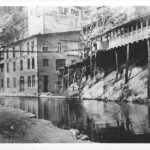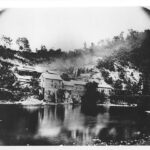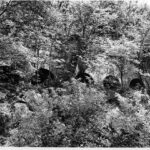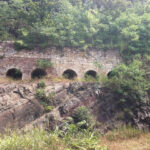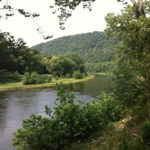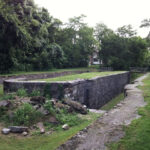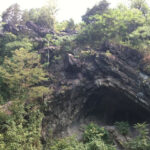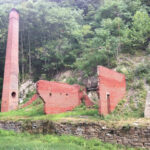Echoes of an Industry
By Ranger Hollie
The first time I biked past the ruins of Round Top Cement Mill, I dismounted and gazed up at it in amazement. There is nothing else like it on the canal. Most striking to me is how, after all this time of idle decay, the cement mill ruins remain quite impressive. It easily captures my imagination and leads me to contemplate what this booming industry, in this now quiet stretch of the canal, must have looked like in its heyday.
Like other businesses along the canal, Round Top Cement Mill opened as a result of canal construction. In the 1830s, while excavating near Roundtop Hill, canal laborers discovered limestone, a key ingredient for cement. Having the ability to manufacture cement close to the job site was hugely beneficial to the canal company; therefore, in 1838, the C&O Canal Company authorized George Shafer to mine limestone and construct a cement mill.
Over the next twenty-five years, the cement mill provided cement for the remaining sixty miles of canal heading west to Cumberland, producing over 200,000 bushels of cement! Cement was packaged into barrels and sacks and shipped downstream by both the C&O Canal and the B&O Railroad.
The mill changed owners in 1863, and was renamed the "Round Top Hydraulic Cement Company." It continued as a booming industry, averaging 2,100 barrels of hydraulic cement per week, making it one of Washington County's most profitable businesses. Over 100 local workers operated the mill, which included a 16-foot-diameter overshot waterwheel, four pairs of grind stones, and eight coal-fired cement kilns. Cement from Roundtop was used all over the area, including in the foundation of the Capitol Building in Washington, D.C.
Advances in technology and industry in the 20th century soon made many companies obsolete, including the Round Top Cement Mill. The plant closed its doors in 1909 after the development of Portland Cement, a slower drying and more durable material.
Standing in front of the cement mill ruins today, it does not seem like over a hundred years has past. Although the landscape has changed and the people are gone, the mill ruins still echo with signs of past commerce, prosperity, hard labor, and industry.
- Post-operations view of the Round Top Cement Mill. By the time this picture was taken the mill had been rebuilt after its third fire which destroyed the whole mill in 1903. However, the company was not able to recover financially after rebuilding the mill and Round Top Cement Mill closed in 1909. Credit: Chesapeake & Ohio Canal National Historical Park
- A close-up view of the Round Top Cement Mill. The wooden structure on the upper right is where the limestone kilns were housed. The kilns could get upwards of 1832°F in order to fire the limestone to make quicklime. The use of wood to shelter the kilns caused the mill to burn to the ground three different times before it closed in the early 20th century. Men who worked at the cement mill used the towpath to get to work and crossed the canal on the foot bridge seen in the foreground. Credit: Chesapeake & Ohio Canal National Historical Park
- Round Top Cement Mill c. 1871. Smoke is coming from the limestone kilns that were housed under a wood and possibly metal awning to keep out the weather. The line stretched across the water is a cable that transported the packed cement barrels to the B & O Railroad for transport. Credit: Chesapeake & Ohio Canal National Historical Park
- This photograph is of the limn kilns at the time the C & O Canal was created as a Historic Monument. The lack of use and preservation allowed second growth trees and vegetation to take over the structures causing further deterioration. Credit: Chesapeake & Ohio Canal National Historical Park
- The eight kilns of the Round Top Cement Mill are nestled in the bank among layers of rock. Credit: Chesapeake & Ohio Canal National Historical Park
- A view of the Potomac River from the Round Top rest area. Credit: Chesapeake & Ohio Canal National Historical Park
- Heading downstream, you’ll find the ruins of Lock 52 and the Bowles House Visitor Center. Credit: Chesapeake & Ohio Canal National Historical Park
- Visitors can cross the bridge shown here to access shops, restaurants, and a bike store in Hancock. Credit: Chesapeake & Ohio Canal National Historical Park
- Most of the western portion of the canal is dry, but a section passing by Hancock is watered. Credit: Chesapeake & Ohio Canal National Historical Park
- The towpath west of the Bowles House Visitor Center makes for a peaceful walk or bike ride. Credit: Chesapeake & Ohio Canal National Historical Park
- Devil’s Eyebrow is one of the many fascinations of geology along the C&O Canal’s 184.5-mile towpath. Credit: Chesapeake & Ohio Canal National Historical Park
- The Round Top Cement Mill ruins stand as a testiment to the canal’s industrial era. Credit: Chesapeake & Ohio Canal National Historical Park
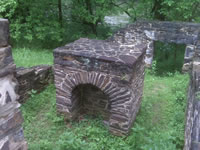
Lock 52
Milepost 122.7
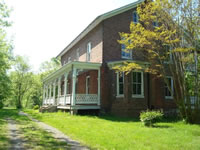
Bowles House Visitor Center
Milepost 123
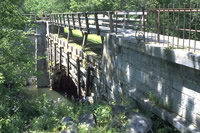
Tonoloway Creek Aqueduct
Milepost 123
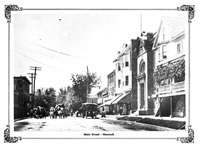
Town of Hancock
Milepost 124.1
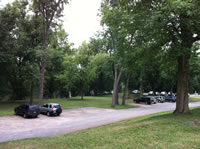
Little Tonoloway Recreation Area
Milepost 124.4
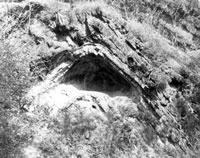
Devil's Eyebrow
Milepost 127.2

Western Maryland Rail Trail
Milepost 112


